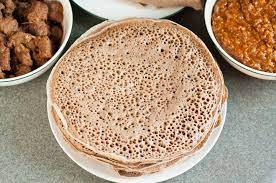
Injera is a traditional Ethiopian sour fermented flatbread with a slightly spongy texture, made from Teff grain flour. Teff is the tiniest grain and one of the earliest domesticated plants that originated in Ethiopia between 4000 and 1000 BC.
It is gluten-free and very high in iron, calcium, protein and fibre. Where teff is not available, it can be substituted by barley flour, millet flour or wheat flour.
The Injera is made large, round and flat shape, often used as the base of a meal, with stews, vegetables, salads, and meats served 0n it. The porous and spongy texture also makes it good at soaking up the maximum amount of sauces and juices.
Ingredients
• 1/4 cup teff flour
• 3/4 cup all-purpose flour
• 1 cup water
• A pinch of salt
• Peanut or vegetable oil
Equipment
• A mixing bowl
• A nonstick pan or cast-iron skillet
Method of Preparation
1. Put the teff flour in the bottom of a mixing bowl, and sift in the all-purpose flour.
2. Slowly add the water, stirring to avoid lumps.
3. Put the batter aside for a day or more (up to three days) to allow it to ferment. 4. During this time, the batter will start to bubble and acquire the slight sourness for which it’s known.
5. Stir in the salt.
6. Heat a nonstick pan or lightly oiled cast-iron skillet until a water drop dances on the surface.
7. Coat the pan with a thin layer of batter. Injera should be thicker than a crêpe, but not as thick as a traditional pancake. It will slightly rise when it heats.
8. Cook until holes appear on the surface of the bread. Once the surface is dry, remove the bread from the pan and let it cool.
Note: If the batter does not ferment on its own, try adding a teaspoon of yeast.
Join the Lughayangu Community!

